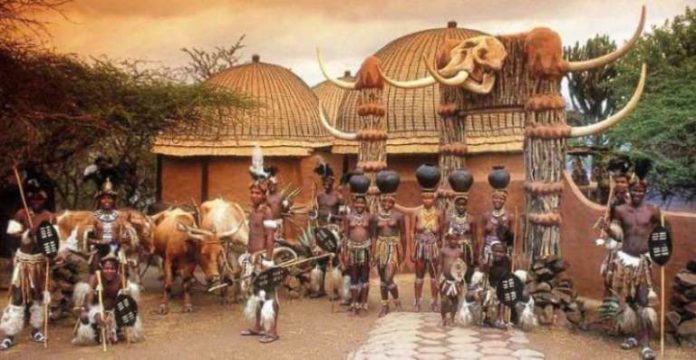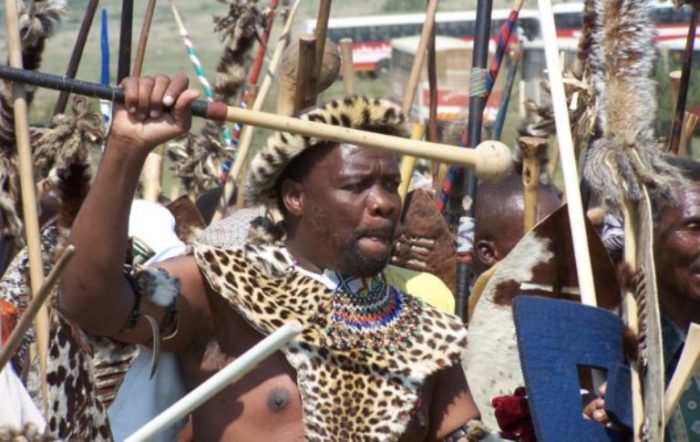Zulu people make up the largest ethnic group in South Africa, this Bantu tribe that made their home in the Kwa-Zulu Natal region of South Africa is big on tradition. From their rich history to their coming-of-age and marriage rites, the Zulu culture is something worth observing. The people love to decorate themselves with beautiful colored beads but when it comes to wedding ceremonies, they go overboard. Their sangomas and inyangas are trusted to take care of their spiritual needs by consulting the spirits of the dead.
Zulu people have some cultural practices like stick fighting that have stood the test of time and the people are distinguished in their native clothing. This is just the tip of the iceberg as there is a whole lot more to learn about the Zulu people.
History and Origin of The Zulu People
Before the emergence of the great Zulu Kingdom, the people were originally a clan (one of the major ones) in the Northern KwaZulu-Natal of today. Their roots are traceable to the Nguni community of Central Africa who chose to migrate southwards along the East Coast. The founding father of the kingdom was Zulu kaMalandela in 1709 when the area was largely occupied by several Nguni clans and communities (also known as the isizwe people or nation); aka isibongo; this refers to their family name or clan.
The Zulus merged with local communities they found on the ground to become part of South Africa’s largest ethnic group – the Bantus. This led to the creation of a powerful kingdom named, Kwa-Zulu Natal (homeland of the Zulu people). As a people, the Zulus take the credit for singularly changing the cultural dominance and history of SA.
Shaka Zulu’s Rule
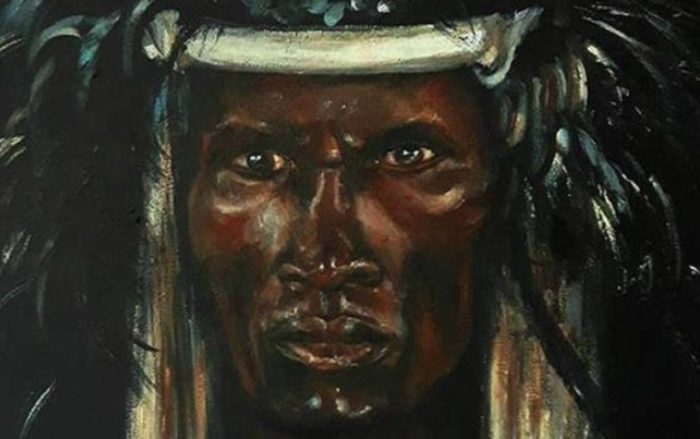
In 1816, the Zulu people formed a powerful and insurmountable state under the rule of Dingiswayo named Shaka Zulu (the commander of the Mthethwa Empire). Shaka’s rule saw a former confederation of tribes unite into an imposing and dominant empire under Zulu hegemony. Impi is a militarized system built by Shaka featuring a standing army, conscription, regimentation, new weaponry, as well as encirclement battle tactics that aided in the Zulu expansion. The Zulu expansion – a key factor of the Mfecane (this means Crushing) depopulated large areas of Southern Africa.
During this period, King Shaka deployed a powerful army regiment under the watch of Mzilikazi charged with the responsibility of raiding tribes on the North. The regiment later disobeyed Shaka and after crafting a plan to continue with the up-North raiding, they formed another dialect of the isiZulu language known as Northern Ndebele this is now part of Zimbabwe).
With their military exploits and drawn-out war against the imperial masters (British supremacy), Zulu people are today regarded as the soul of South Africa. Even with the advent of foreigners (Europeans and Indians) and other African ethnic groups in SA, the Zulu tribe remains the country’s main ethnic group. Though you would find the largest concentration of Zulu people in Kwa-Zulu Natal (KZN), their presence is felt in other African countries such as Zimbabwe, Zambia, Tanzania, and many others.
IsiZulu is the Language of Zulu People
The Zulu people speak isiZulu which is among the 11 official languages of South Africa. SA has about 11.7 6 million people who speak isiZulu as their first language and another estimated 15.7 million who speak it as their second language. The Zulu language is spoken in other countries like Botswana, Swaziland, Malawi, Lesotho, and Mozambique. Since the speakers of Xhosa, Ndebele, and Swati understand isiZulu, it became the lingual Franca from Natal down to Zimbabwe. However, these people only speak the pidginized version popularly known as Fanagalo.
IsiZulu is South Africa’s most widely spoken language followed by other languages such as Xitsonga, Sesotho. Even though the Zulu language is highly developed, it is not complete; it borrowed copiously from other languages like English and Afrikaans.
The dialectal differences in the isiZulu language are just a few in number, Lala and Qwabe, and there is also the pidginize version. The speakers of the Northern Ndebele dialect are now part of Zimbabwe.
The Zulu People Have A Rich and Colorful Culture
The pre-colonial Zulu people were known for diverse cultural practices, many of which stood the test of time. However, they are now a bit modernized with the coming of civilization.
The Umhlanga (Reed Dance) Ceremony Of The Zulu People Is Targeted At Promoting Virginity

Reed Dance or Umhlanga is an annual event celebrated by Zulu people. The event which became fully established in 1984 is hosted very close to Nongoma at the royal capital. It was performed by intombis (young women from the kingdom) in the presence of the sitting monarch and his guests. The Umhlanga was practiced to restrain sexual immoralities and promote pride in virginity. At every Umhlanga ceremony, there are displays of beadwork on the dancers and the guests. The king leverages the ceremony to air his views on certain burning issues about the Zulu nation.
Coming of Age For Girls – the Umemulo Ceremony

Another ceremony targeted at the intombis of the Zulu nation is the Umemulo. This is a coming-of-age ceremony or puberty ceremony strictly for nubile ladies who have attained the ripe age of 21. It represents a remarkable transition in the life of a girl child as it symbolizes that a young lady is ready to accept eligible bachelors into her life and even get married.
The prelude to the Umemulo demands that young ladies be separated from other people; this lasts for a while, marking their changing status from little girls to fully-fledged women.
At the end of the separation period, the young women are re-reincorporated into the society at the Umemulo ceremony which is characterized by feasting, dancing, and the ritual killing of animals. The courting days of a Zulu girl begin at the end of the ceremony when she will be declared ready for marriage. The Zulu culture does not frown on a girl taking the first step towards a possible suitor; the intombi will send her love interest a love letter consisting of beads. Different meanings are ascribed to different colors of beads and there are particular meanings in certain combinations.
Dating will only commence after a Zulu man pays his love interest a visit, though they can also send a letter declaring their love for an intombi. If the man’s love is reciprocated, the woman lets him know and from then onward, they can appear in public together without people raising an eyebrow. The parents will only come in when the man asks for the girl’s hand in marriage and informs the family. According to the Zulu people, the greatest misfortune of life is childlessness and having just girls. A Zulu marriage cannot be declared permanent until it is blessed with a child – a baby boy in particular.
The Zulus Celebrate Manhood Through Stick Fighting

Stick fighting signifies the celebration of manhood among men of Zulu origin. From the tender age of five, every male child born into the Zulu kingdom must start learning the art of stick fighting. There are several reasons why Zulu men want to excel in stick fighting.
- For sporting purposes
- Self-defense
- Proving skills or manliness,
- Avenging insults made towards them
- To publicly address disputes through duels
In stick fighting, a fighter’s goal is to maim the opponent which may result in death. At the first sight of blood, the duel is declared over and the onus is now on the winner to tend to the injuries of the loser. Death during stick fighting rounds does not attract charges, especially if both fighters abided by the rules. Below are some of the rules of stick fighting,
- Fighters are only allowed to fight with sticks
- You cannot hit an opponent whose stick got lost
- Stick fighting is only possible for men within the same age bracket.
Religious Beliefs Of the Zulu People
Like several other African traditional religions, the Zulu people believe in the existence of God – a creator called uNkulunkulu (Very Big One) who lives in the sky, interacting in their daily lives. The supreme being of the Zulus is also referred to as UMvelinqangi (One Who Came First). No one has ever laid eyes on this uNkulunkulu and as such, they don’t perform ceremonies for God. All the Zulu ceremonies are targeted at the ancestors to mediate between the people and uMvelinqangi.
According to Zulu beliefs, several elements inhibit the human body:
- Inyama yomzimba or umzimba – this is the physical body that we can see, feel, and touch
- Umoya womphefumulo or umoya – this represents life force or the breath
- Isithunzi – this talks about the “shadow,” personality, or prestige
- Idlozi – ancestral spirit of the Zulus
When death strikes a Zulu man, his umoya promptly exits from the body. However, if the deceased met certain conditions during his lifetime, his isithunzi lives on and becomes an ancestral spirit (idlozi). Being generous and treating people with respect (behaving with ubuntu) enhances a person’s isithunzi – that is his prestige and moral standing in the community. On the flip side, a man’s isithunzi may reduce or completely fade away if the person’s attitude to others is perceived as negative.
The Zulu people also display a strong belief in magic which is used to explain things that are beyond their understanding like strange illnesses, bad luck, and the likes. The Zulus usually explain such situations away by saying that an angry spirit is responsible. When they are struck by bad luck or serious ill-health, a typical Zulu man will consult a soothsayer/ sangoma (diviner) or herbalist (inyanga) who communicates with ancestral spirits through the use of prayers and natural herbs to bring an end to the issue.
The Role Of The Sangoma and Inyanga in the Zulu Society
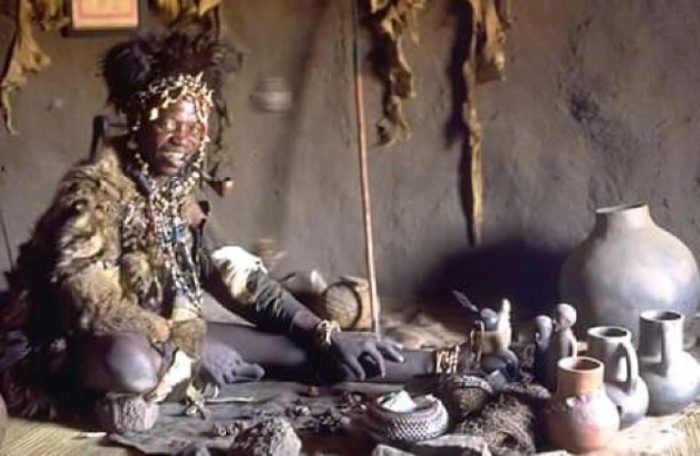
A Sangoma is a diviner or someone who goes through the divination process to invoke the spirit of the ancestors in order to determine a problem (this is like diagnosis). After the sangoma is done with divination, an inyanga (herbalist) comes in to prepare the right mixture (muthi) which the sick are instructed to drink in a bid to influence their ancestral spirits. Muthi comes in two distinct types;
- Umuthi omhlope – this is the white muthi that has only positive effects like prevention and reversal of misfortune, or healing of all kinds of sicknesses.
- Umuthi omnyama – This is the back muthi which when uses, brings ailments or death to others. It also has the power to bestow the user with ill-gotten wealth. Users of black muthi are viewed as witches and once they are identified, society wastes no time in shunning them.
These functions are indications that both the sangoma and inyanga had very crucial roles to play in the ancient Zulu society. To date, a majority of Zulu people still believe in the efficacy of the services of their sangoma and inyanga – this is the sole reason why Christianity found it difficult in gaining a strong foothold among the people of Zulu origin. Even when it looked like the Zulus were beginning to accept Christianity, it only happened in a syncretic fashion. One Zulu man named Isaiah Shembe who is viewed in the light of the Zulu Messiah presented his people with a form of Christianity that incorporated most of their traditional customs – he is the founding member of Nazareth Baptist Church.
Ukweshwama Ceremony Is An Annual Ceremony To Celebrate New Harvest
Ukweshwama is one of the major ceremonies practiced by the Zulu people and it entails the killing of the bull. The ceremony is usually hosted annually in celebration of a new harvest – the Zulus gather together to offer prayers to their ancestors and creator, thanking them for a good harvest.
During the Ukweshwama, the crowd will be cheering as a new brigade of young warriors will be requested to prove a bull’s courage by confronting it. As the strength of the beast expires, the warriors will be inheriting it and there is the belief that the young warriors only inherit the powers of the bull for onward transmission to the sitting Zulu monarch.
Spirituality and the Power of Ancestors
Though the Zulu people believe in the existence of a creator, their more strongly held belief is in the spirit of their ancestors. AmaThongo or amaDlozi as their ancestral spirits are called has both power and might to intervene in the lives of the natives, either for good or ill. Even among the modern Zulu of the 21st century, this belief holds a strong and palpable place.
All through the passage of life, the Zulus remember those who have gone to the great beyond – at birth, during puberty, marriage ceremony, and death. There are several rituals practiced by the Zulus to pay homage to the dead, as well as invoke their blessings. To appease the ancestors, the tribe uses animal sacrifice home-brewed beer, and herbs.
The Zulu people worship their ancestors and all the sacrifices and offerings made are in order to get fortune, assistance, happiness, good luck, guidance, good health, blessings, and protection from their ancestral spirit. They believe that their ancestors still walk the earth and often appear in dreams, in form of snakes, ailments, and so on. In the unKulunkulu (the greatest of the great) where the ancestors are believed to live, they work in accord with the creator, intervening in people’s lives. This spirit world is where the ancestors stay to receive all the sacrifices offered to them.
What Happens at Funerals Among the Zulu People?
Every Zulu person that passes on must be buried according to Zulu tradition. Death according to them is considered to be people’s deeper connection with creation. Any dead person that was not buried in the traditional way of the Zulus may likely become a wandering spirit. Thus, rituals must be made with animals to send the deceased off and to aid the person in his journey to the great beyond. Part of the send-off includes throwing the dead person’s property into his grave before covering it with sand.
The Zulu People Have Some Fascinating Folklores
Zulus all over the African continent are associated with several folklores but there is one that is very predominant. Getting old among the Zulu people is considered a huge blessing and life will continue after death. This belief is taken from a popular myth that people from the beginning of time never died but lived on for years on end as the unKulunkulu did not think that death is necessary. Therefore, the creator sent the Chameleon with a message to the world to tell people that they will not die. The creator never minded that the chameleon moves very slowly before picking him for this all-important errand and patiently waited for its reply.
It happened that the chameleon got distracted by wild berries along the way and stopped to fill its stomach thinking that unKulunkulu will never find out. Unfortunately, the creator did not only find out, but he also got very incensed and sent for the lizard who answered swiftly. UnKulunkulu then asked the lizard to go tell the people that they will die.
The lizard sped off instantly past the wild berry-eating chameleon and promptly delivered God’s message to the people. It took a very long time before the chameleon could get to the people with his version of the message which angered them. The people shouted at the chameleon, asking why he wasted so much time as the lizard has already delivered the message of death! For this reason, the Zulu people came to regard old age as a special privilege from unKulunkulu – to date, the aged are perceived as sacred and deserving of respect.
The Origin of Beadwork Among the Zulus
For the people of the Zulu tribe, the creation of beautiful beadwork dates as far back as the period of war. The beadwork produced during that time was known as medallions of war (iziqu). These beads were used to adorn the necks of the Zulu warriors in a criss-cross formation falling across the wearer’s shoulder. This kind of assemblage of beads on warriors of Zulu origin represents bravery.
Before the Zulus started using glass, they derived their beadwork from seeds, wood, and berries. The Zulus only started having access to glass with the arrival of Europeans who began to trade glass with the Portuguese.
The Inherent Meaning of Beadwork
On its own, beadwork serves as a form of communication among the Zulu people.
Wearing multiple beads at the same time is a connotation of great wealth in the tribe – as one becomes wealthier, he adds more beads to signify his improving financial standing.
Beadwork conveys such information as the age of the wearer, his or her marital status, and gender.
There is always a message to be conveyed by each design of beadwork. However, to be able to read the inherent message correctly, a person must be conversant with the context. The area where beadwork is produced also has some message to convey. The structure and colors of beads may just be for decoration but more often than not a message is embedded into it.
Beadwork on Apparel
In the Zulu kingdom, children, women, and men adorn themselves with beadwork which indicates all sorts of meanings, depending on an individual’s stage of life.
- People who are searching for love wear beadwork, so do those that are already courting.
- When beadwork is excessively decorative, it may be targeted at grabbing the attention of a love interest.
- When people of the opposite sex exchange beadwork, it is considered a form of communication of their interest in love.
- It is perceived that an eligible bachelor wearing multiple necklaces received them as gifts from several intombis who have eyes for him.
- A young man’s prestige in Zulu society tends to increase as he adds more and more bead gifts from young girls.
When an intombi is transiting to a married woman, she wears a beaded cloth apron over a pleated skirt made of leather. As the woman matures and advances into older age, she will sport a detailed display of beadwork in her long cowhide skirts (below the knee level) and headdresses. Nubile girls can also wear long skirts, but Zulu men are a bit more conservative when it comes to wearing beadwork.
The Connotation of Color and Shape in Beads
Various forms of beadwork sport different color schemes which are four in number
- Isisshunka – This consists of the colors – white, dark green, light blue, pale yellow, red, pink, and black. For this color scheme, there is no specific meaning.
- Isithembu – This consists of light blue, bright yellow, grass green, black, and red; the color scheme derives from clan areas.
- Umzansi – White, grass green, dark blue, and red. This equally derives from clan areas.
- Isinyolovane – Combo of any colors that are not consistent with the known color schemes. This often relates to the connotation of charm and perfection.
As a form of symbolism and communication among the Zulus, the colors in addition to varying shapes of beadwork connote different meanings;
- When beadwork is designed in triangular shapes, the direction of its tip signifies whether the wearer is married or single.
- The beadwork worn by married women is designed with a couple of triangles joined together in a diamond shape pattern – this is the recognized fertility symbol among the Zulu people.
- For the married men, their own beadwork will be designed in such a way that the tips of the two triangles form an hourglass shape.
- The entire seven colors of beads represent spirituality, emotions, as well as the status of an individual in society.
It is not safe to assume that the bead color system is standard across the country which may lead to confusion and misrepresentation. An area might take the green color to symbolize jealousy, another might just see it as a symbol for grass. Thus, it is necessary for people to understand the origin of any beadwork before they can interpret the correct meaning inherent in it.
The Zulu People Are Known For Their Colorful Apparels
The Zulu people of Africa have different kinds of attires for its people depending on variables like sex, age, marital status, and more. What an intombi would wear is totally different from the dress code expected of a married woman. A pregnant woman has some special clothing for her enlarging form.
Clothing For Zulu Men
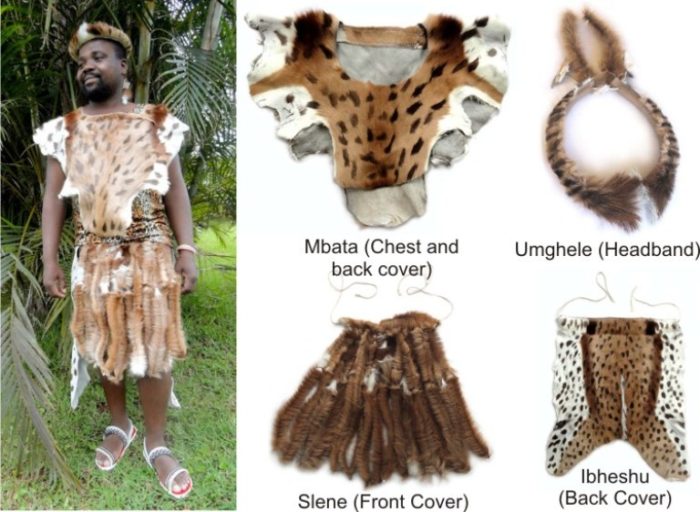
In ancient times, Zulu men would tie a leather belt at their waist to suspend two strips that would hang down from both front and back and this may be all the clothing he requires.
With time, Zulu men started covering their genitals with the umcedo (underwear). Slene served as the front cover, and mbata is coverage for the chest and back. Performing the function of modern-day’s trousers is the ibheshu – the material for making the ibheshu comes from calfskin. On the head of every married man in Zulu kingdom sits the headdress umqhele and to boost his normal size, a Zulu warrior will adorn his upper arm and below the knee with amashoba (the material for the amashoba comes from tufts collected from the tail of a cow).
Ibheshu which comes from calfskin is known to have a soft texture; there are two variations of ibheshu:
- The knee-length ibheshu – is commonly worn by younger Zulu men because of its practicality for vigorous activities which include fighting, hunting, and dancing.
- The ankle-length ibheshu – this type of ibheshu is considered to be more apt for older Zulu men that have lost interest in energy-sapping activities.
Majorly, the kind of materials that go into the makings of traditional attires for Zulu men are animal skins and feathers and it is worthy of mention that the type of skin worn by a man indicates his financial status.
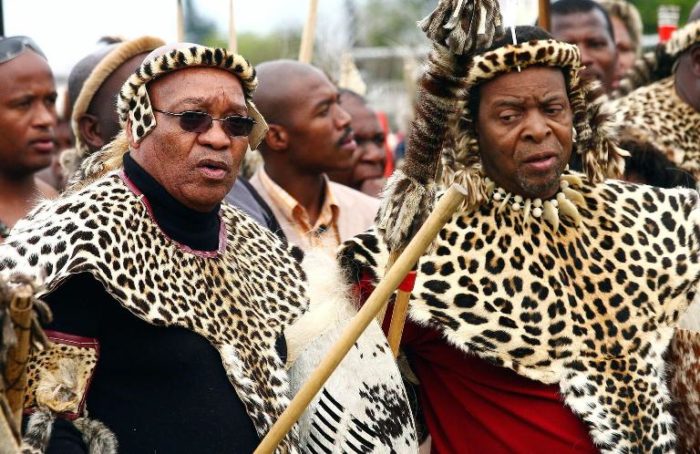
Leopard skin is normally seen on members of the royal family as they are the ones who can afford them; these financial strata include the likes of the izinduna (army generals) and the chiefs.
In the Zulu Kingdom, the rate at which men are allowed to wear apparel made from leopard skin differs. The Zulu sitting monarch may wear the sought-after leopard skin to his heart’s content, but the entitlement due to a chief maybe just for his headdress.
The wedding day of an average man in the Zulu kingdom is when he is entitled to put on leopard skin.
Attires For Zulu Women
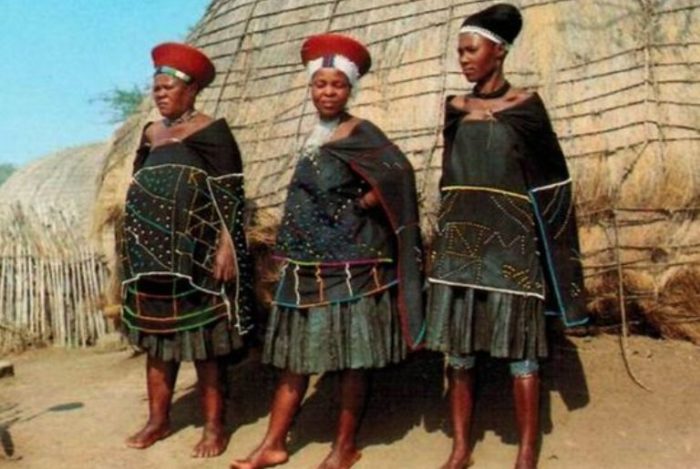
A girl in Zulu land goes through changes from kids, to intombi, engaged, bride, makoti, older woman, and the likes.
The unmarried ladies wear a short grass processed skirt or a beaded cotton string. The breasts are left completely bare and her body spruced with beadwork. She wears an izincu which is elongated strips of twisted beads around her elbows, ankles, and waist. Only an officially engaged woman can be allowed to start growing her hair. With a decorative cloth, an engaged woman covers her breasts, showing respect to her man and warning others that she is off the marriage market.
Once a woman goes into a man’s house as his makoti, she must cover up all parts of her body with heavily beaded cloth and a heavy knee-length cowhide skirt. While ancient Zulu women were covered up with skin or material, modern-day women prefer beaded bras.
Isibamba is a dry grass processed thick belt worn by pregnant women who leveraged its glass or plastic beadwork as a support to their additional bodyweight and swelling breasts.
Ancient Zulu Hats Were Sewn Into the Hair
The Zulus have a grass-processed hat known as the izicolo’ hats. These hats which are often intertwined with white and red thread are also worn by married women. Each of the clans in Zululand is associated with different sizes of izicolo hats but the hot valleys of the SA Tugela River wear the largest hats. They protect themselves from the scorching sun with their large hats.
When an intombi becomes a wife, the traditions of the Zulu people demand that her hair should be treated with herbs, straightened, and the izicolo hat sewn into it. The hat rots on the makoti’s head over a period of time following which the hair will be washed and another hat is sewn onto it. A woman whose husband is absent has no right to remove the hat and pretend to be an intombi.
The present-day Zulus no longer sew hats into their hair but wear them on only special occasions.
Zulu People Have Some Fascinating Dances
The Zulus are popular for the use of drums which is a vital part of their celebrations. The beating of the drums is often accompanied by chanting and dancing. The tribe can lay claim to the goatskin processed ingungu drum; this is usually played at occasions and ceremonies. Playing this drum means positioning a compressed piece of reed on it and, vibrating it with both hands. The normal time to play the ingungu is when an intombi starts menstruation; it is played in celebration of the event.
The Zulu culture can boast of a good number of dances in celebration of different areas of life:
- The hunting dance – This symbolizes bravery required to hunt; Zulu men tuck into this dance by imitating movements made by hunters. The dance is usually performed prior to a hunting expedition. In a bid to avoid injury, the dance encourages the use of sticks as opposed to spears.
- The dance of the small shield – This is a rhythmic dance encouraging military unity among the Zulu warriors; it is only on royal occasions that this dance is performed.
Zulu Cuisine
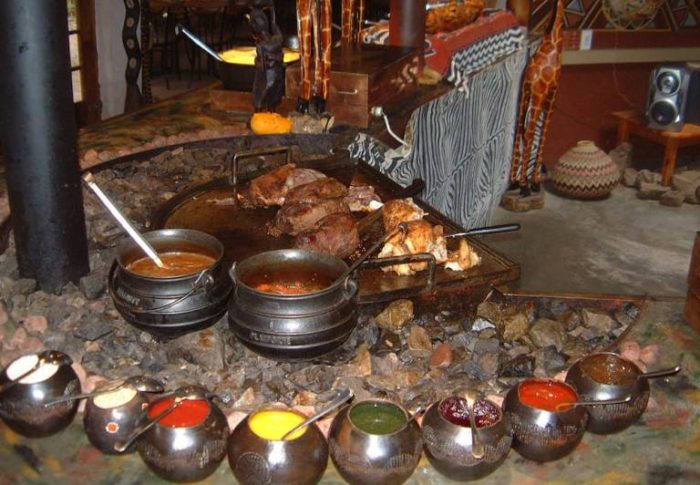
The rich culture and history of the Zulu tribe mirror the people’s cuisine. Their habitat in the midst of wildlife and wilderness notwithstanding, Zulu people favor vegetarian food which includes stuff like grain and veggies. It is only on special occasions that the tribe kills animals such as ox; this is majorly used for sacrifice.
In every Zulu household, you will find foodstuffs like sorghum and maize-based pap, potatoes, fermented milk, pumpkins, traditional African porridge, locally brewed beer, and more. You can tell the social status and age of a man by his food portions of meat dishes. A typical Zulu man used a wooden bowl and spoons for eating; he washes his hands before meals and rinses his mouth after meals.
Traditional Beverages of the Zulu People
The fermented milk which is known as Amazi is a delicacy among the tribe and they only share it with family members. They use a gourd for curdling the milk; the taste is said to be a mix of plain yogurt and cottage cheese. According to the belief of the Zulus, the Amasi boosts digestion, as well as makes men strong.
Zulu people also brew their own beer; this is a three-day process carried out by women. the local beer is processed with sorghum (grain plant) and maize soaked in water overnight. They then boil it with sorghum, The beer will be ready on the third day after filtering with the aid of a sieve and must be consumed before the day ran out.
Expectations From a Nubile Zulu Girl
The father of a nubile Zulu girl is the one who makes arrangements for her coming out ceremony. This serves as the girl’s introduction to society, it equally announces her availability for marriage. According to the Zulu tradition, A lady is the one who has an upper hand as she always makes the first move on her love interest. In fact, the onus is on a Zulu intombi to go get her groom. Once a girl consents to marriage, it will set off negotiations between the two families and the topic of discussion will center on the number of cows to be given as Lobola.
In Zululand, the language of love lies in the extensive use of beads and it is the bride’s duty to create two matching necklaces for her and the groom. Once the duo shows up in public with the same design of necklaces in matching colors, the message goes out that they are an item.
Pre-Wedding Preparations According to Zulu Customs
A man and woman who have decided to spend the rest of their years together will be put through some long-held processes.
- The senior girls in the intombi’s village (kraal) will give consent for the intending bride and groom to spend a few nights under the same roof.
- Periodically, examinations are carried out on the girl to ascertain if she has lost her virginity.
- In the event that a girl gets deflowered during this period, her family will fine the groom and his family, and the two will be wedded without wasting time.
The gift of cattle a groom presents to his bride’s family during this time will become insurance for the lady if her husband dies, leaves her unjustly, or rejects her. The cattle also supports the bride and any children she had for the man when the need arises.
A Zulu Wedding is a Display of Rich African Culture
For a Zulu bride, accepting to marry a man has very deep meaning, most notable among them is disconnecting from her own ancestral line to go join the ancestral lineage of her husband. Thus, she makes huge preparations for this transition.
On her wedding day, the arm and legs of a Zulu girl will be decorated with white and red ocher designs. She will have bags of pebbles tied to her ankle for a rhythmic effect during dancing. Her veil will be the type created from twisted fig leaves and beads. She wears a goat’s hair fringe around her neck with oxtail fringes tied to her knees and elbow. The assegai (a miniature knife symbolizing a girl’s virginity) will come to play only if the bride remained a virgin till her wedding day; the assegai will point up symbolizing virginity but points down after the consummation of the marriage.
The bride makes a conscious effort to look beautiful by changing her apparel three times. The wedding ceremony is often hosted in the homestead of the groom where the two in-laws will display their dancing steps. The dance is the highlight of Zulu weddings and at a certain point, the bride joins in, kicking her legs high up into the air in a bid to prove to her mum that she wedded as a virgin.
Before the end of the ceremony, the groom’s family will slaughter a cow, signaling their acceptance of the new makoti. With the crowd looking on and cheering, the new wife will go and put some money in the belly of the slaughtered cow; this is a sign that she accepts and now belongs with the groom’s family.
At the end of the wedding ceremony, the new makoti will fulfill the ukwaba tradition by presenting her new family with gifts such as a blanket; both the living and the dead members of the family will receive the gifts, including their extended family. Once they collect the blanket, the groom’s family chooses a location where everyone will see and use the blanket to cover themselves.
Lobola Negotiation in Zulu Land
The bride prize system among the Zulu people is called lobola and it is paid with cattle, either before the wedding ceremony or after. The groom goes to his father’s herd to select the cattle to be used in paying his bridewealth; this according to Zulu belief perpetuates the family heritage. The formalized system of lobola payment approves ten cattle for commoners (including the ingquthu cow that is meant for the mother), siblings of hereditary chiefs can pay 15 cows as lobola, while any man who wishes to marry the daughter of a Zulu chief will be ready to part with 20 cows. The payment of lobola is very important in Zululand as it guarantees the bride’s father that his daughter will be properly taken care of.
